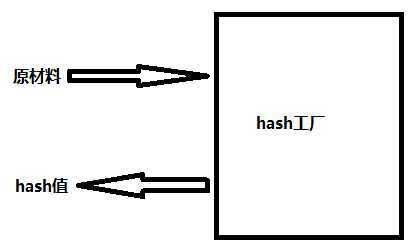hash一类算法,该算法接受传入的内容,经过运算得到一串hash值
hash值的特点:
I 只要传入的内容一样,得到的hash值必然一样
II 不能由hash值返解成内容
III 不管传入的内容有多大,只要使用的hash算法不变,得到的hash值长度是一定
用途1:特点II用于密码密文传输与验证
用途2:特点I、III用于文件完整性校验
hash算法就像一座工厂,工厂接收你送来的原材料(可以用m.update()为工厂运送原材料),经过加工返回的产品就是hash值

import hashlib m=hashlib.md5() m.update(‘hello‘.encode(‘utf-8‘)) m.update(‘world‘.encode(‘utf-8‘)) res=m.hexdigest() # ‘helloworld‘ print(res) m1=hashlib.md5(‘he‘.encode(‘utf-8‘)) m1.update(‘llo‘.encode(‘utf-8‘)) m1.update(‘w‘.encode(‘utf-8‘)) m1.update(‘orld‘.encode(‘utf-8‘)) res=m1.hexdigest()# ‘helloworld‘ print(res)
1、密文
# 模拟撞库 cryptograph=‘aee949757a2e698417463d47acac93df‘ import hashlib # 制作密码字段 passwds=[ ‘alex3714‘, ‘alex1313‘, ‘alex94139413‘, ‘alex123456‘, ‘123456alex‘, ‘a123lex‘, ] dic={} for p in passwds: res=hashlib.md5(p.encode(‘utf-8‘)) dic[p]=res.hexdigest() # 模拟撞库得到密码 for k,v in dic.items(): if v == cryptograph: print(‘撞库成功,明文密码是:%s‘ %k) break # 提升撞库的成本=>密码加盐 import hashlib m=hashlib.md5() m.update(‘天王‘.encode(‘utf-8‘)) m.update(‘alex3714‘.encode(‘utf-8‘)) m.update(‘盖地虎‘.encode(‘utf-8‘)) print(m.hexdigest())
# 验证文件完整性,传入文件大小,在八处取数据进行md5哈希计算,得到哈希值。 def check(size): with open("test.ini",mode="rb") as f: m = hashlib.md5() content = f.readline() point = 0 while point < size: m.update(content) point += size//8 f.seek(point,0) code = m.hexdigest() return code print(check(864))
原文:https://www.cnblogs.com/zhubincheng/p/12609523.html